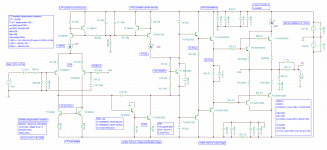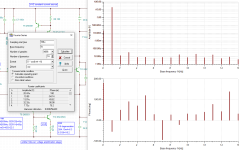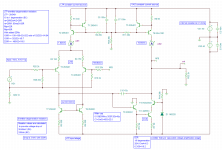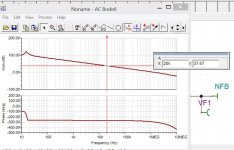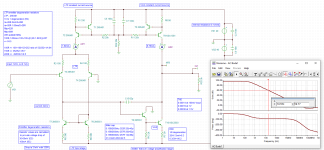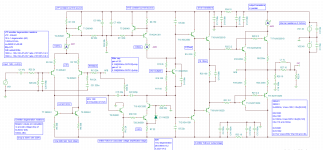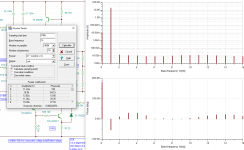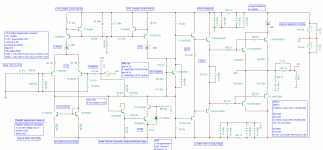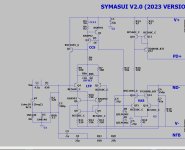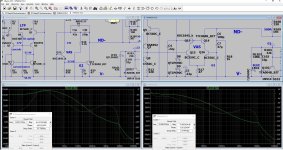Values seem ok ,Hi. How to add models
Was few line errors.
I fixed and included Zip File with working .LIB files , Tina Macro. TSM files and Schematic
you can use macro wizard, or just copy the .TSM files to your user library
Attachments
R2 should be same value as feedback resistor R12How did you get such low distortion?
I have put it together, but I can only manage 0.04
and place R2 last in the chain of the input.
make C1 larger 10u
C7 10n and R18 10k
important that current source is set to 1ma
no more. since using 3.3k tail resistors.
think I gave you copy of the whole deal
Basically as mentioned
current source needs to be 1ma
then adjust R18 so there is low DC offset on output.
then set bias.
usually when its around .04% current isn't correct and their is
offset.
current source needs to be 1ma
then adjust R18 so there is low DC offset on output.
then set bias.
usually when its around .04% current isn't correct and their is
offset.
I tied keeping everything to a minimum 🤣
LTP - 2 transistors
CCSs for LTP and VAS - 2 transistors each
current mirror - 2 transistors
VAS - 2 transistors
EF3 OPS and paralleled output driver transistors - 6 in total
Called this BB2234
B - BJT transistors for the input LTP
B - BJT transistors for the output stage
2 - LTP is comprised of only two transistors (not cascoded)
2 - VAS is comprised of two transistors: VAS and VAS EF
3 - output stage is three betas multiplied triple transistors
4 - number of output transistors (two paralleled on each side of swing)
Can I build this as is in schematics? Will this be stable?
Getting around 0.00026% THD in sim
PSU rails are 40V coming from 30V transformer
LTP - 2 transistors
CCSs for LTP and VAS - 2 transistors each
current mirror - 2 transistors
VAS - 2 transistors
EF3 OPS and paralleled output driver transistors - 6 in total
Called this BB2234
B - BJT transistors for the input LTP
B - BJT transistors for the output stage
2 - LTP is comprised of only two transistors (not cascoded)
2 - VAS is comprised of two transistors: VAS and VAS EF
3 - output stage is three betas multiplied triple transistors
4 - number of output transistors (two paralleled on each side of swing)
Can I build this as is in schematics? Will this be stable?
Getting around 0.00026% THD in sim
PSU rails are 40V coming from 30V transformer
Attachments
Last edited:
Yup 😎think I gave you copy of the whole deal
Found this on the net:
Will give it a try one more time later.
H
HAYK
zipped file doesnt want to openI added bellow to visualize the open loop gain. You have less than 40db@20 kHz, try to make it above 60db for perfect sound.
H
HAYK
Erase the .zip to leave the .TSM.
Sorry, it is the loop gain. It shows how much NFB you apply by frequency. The generator is in series with the feedback and the voltage across it devide each other. The phase is wrong as I forgot to multiply by -1. You need to apply more sofisticated compensation rather than simple Miller capacitor.
Sorry, it is the loop gain. It shows how much NFB you apply by frequency. The generator is in series with the feedback and the voltage across it devide each other. The phase is wrong as I forgot to multiply by -1. You need to apply more sofisticated compensation rather than simple Miller capacitor.
Last edited by a moderator:
Ok, one more attempt here.
Will be considering building this with all parts as shown.
Will be considering building this with all parts as shown.
Attachments
Last edited:
H
HAYK
.5PPM 20Khz + 75DB OLG @ 20Khz best I've ever simulated. Blows the current champ "wolverine" away !
Your version is what drives the olde "HH" english LATFET power amps.
OS
Attachments
H
HAYK
Look harder, wolverine just has 61db. Symasui has 75db.
Read it.
But , wolverine far exceeded what I expected. reviews of it were stellar.
Wolverine CAN'T get 75db @ 20Khz -It is what it is.
I could push Symasui to 80 db , I can't imagine "catharsis" @ 90db.
You don't need 90db to get sub ppm at 20Khz , 70 can do it , in fact 61 (wolverine) can do it.
In the real world ...
What I am astonished at is that symasui can do 75 without a 3'rd stage..
PS - it was 2 pole compensation that made symasui go from 65 to 75.
OS
Read it.
But , wolverine far exceeded what I expected. reviews of it were stellar.
Wolverine CAN'T get 75db @ 20Khz -It is what it is.
I could push Symasui to 80 db , I can't imagine "catharsis" @ 90db.
You don't need 90db to get sub ppm at 20Khz , 70 can do it , in fact 61 (wolverine) can do it.
In the real world ...
What I am astonished at is that symasui can do 75 without a 3'rd stage..
PS - it was 2 pole compensation that made symasui go from 65 to 75.
OS
Last edited:
H
HAYK
Even with 60db, the Frank's voice should be clean, unless the built ones are not yet. Above 70db to my aged ears there is no any enhancement. Purifi applies 90db flat up to 64khz 87db as the circuit is oscillating.
ToI adjust by ears first I pass the "Happy Together" of the Turtles. It requires 40db NFB@20Khz, for me an amp is not audio if it fails. It needs 50db to get the "Sing Sing Sing" of B. Goodman to get it pleasant . 60 dB is needed for the requiem of Verdi, 300 voices+70 instruments. 70 db to get Mozart' celestial. MP3 128 or wave file are the same.
ToI adjust by ears first I pass the "Happy Together" of the Turtles. It requires 40db NFB@20Khz, for me an amp is not audio if it fails. It needs 50db to get the "Sing Sing Sing" of B. Goodman to get it pleasant . 60 dB is needed for the requiem of Verdi, 300 voices+70 instruments. 70 db to get Mozart' celestial. MP3 128 or wave file are the same.
- Home
- Amplifiers
- Solid State
- JAT501 simulated using TINA TI and possible improvements
